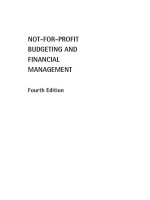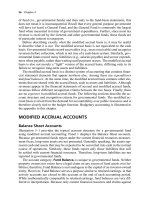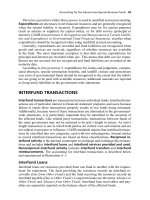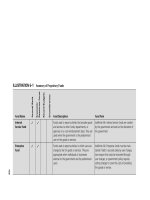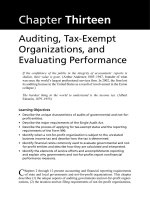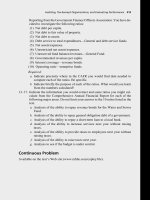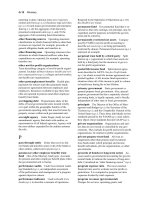Not for profit accounting, tax, and reporting requirements 4e
Bạn đang xem bản rút gọn của tài liệu. Xem và tải ngay bản đầy đủ của tài liệu tại đây (5.22 MB, 268 trang )
NOT-FOR-PROFIT
ACCOUNTING, TAX,
AND REPORTING
REQUIREMENTS
Fourth Edition
NOT-FOR-PROFIT
ACCOUNTING, TAX,
AND REPORTING
REQUIREMENTS
Fourth Edition
EDWARD J. McMILLAN, CPA, CAE
John Wiley & Sons, Inc.
Copyright © 2010 by John Wiley & Sons, Inc. All rights reserved.
Published by John Wiley & Sons, Inc., Hoboken, New Jersey.
Published simultaneously in Canada.
No part of this publication may be reproduced, stored in a retrieval system, or transmitted in any form or by any
means, electronic, mechanical, photocopying, recording, scanning, or otherwise, except as permitted under
Section 107 or 108 of the 1976 United States Copyright Act, without either the prior written permission of the
Publisher, or authorization through payment of the appropriate per-copy fee to the Copyright Clearance Center,
Inc., 222 Rosewood Drive, Danvers, MA 01923, (978) 750-8400, fax (978) 646-8600, or on the web at www.
copyright.com. Requests to the Publisher for permission should be addressed to the Permissions Department, John
Wiley & Sons, Inc., 111 River Street, Hoboken, NJ 07030, (201) 748-6011, fax (201) 748-6008, or online at
/>Limit of Liability/Disclaimer of Warranty: While the publisher and author have used their best efforts in preparing
this book, they make no representations or warranties with respect to the accuracy or completeness of the
contents of this book and specifically disclaim any implied warranties of merchantability or fitness for a particu-
lar purpose. No warranty may be created or extended by sales representatives or written sales materials. The advice
and strategies contained herein may not be suitable for your situation. You should consult with a professional
where appropriate. Neither the publisher nor author shall be liable for any loss of profit or any other commercial
damages, including but not limited to special, incidental, consequential, or other damages.
For general information on our other products and services or for technical support, please contact our Customer
Care Department within the United States at (800) 762-2974, outside the United States at (317) 572-3993 or
fax (317) 572-4002.
Wiley also publishes its books in a variety of electronic formats. Some content that appears in print may not be
available in electronic books. For more information about Wiley products, visit our web site at www.wiley.com.
Library of Congress Cataloging-in-Publication Data:
McMillan, Edward J., 1949-
Not-for-profit accounting, tax, and reporting requirements / Edward J. McMillan. — 2nd ed.
p. cm.
Includes index.
ISBN 978-0-470-57538-3 (pbk.)
1. Nonprofit organizations—United States—Finance. 2. Nonprofit organizations—United States—Accounting.
3. Nonprofit organizations—Taxation—United States. 4. Financial statements—United States. I. Title.
HG4027.65.M363 2010
657'.980973—dc22
2010003129
Printed in the United States of America.
10 9 8 7 6 5 4 3 2 1
To my beautiful daughter, Terryn, Spencer,
her dedicated husband, David,
and their three terrific boys,
Patrick, Benjamin, and John
vii
About the Author
Edward J. McMillan, CPA, CAE, has spent his entire career in not-for-profit financial
management. He has served as the controller of the national office of the Associated
Builders and Contractors and as the finance and membership director of the American
Correctional Association. In 1993, McMillan was appointed faculty chair for finance
for the United States Chamber of Commerce’s Institutes for Organization Manage-
ment program.
McMillan has written several books on not-for-profit financial management. His
publishers include the American Society of Association Executives, McGraw-Hill, the
U.S. Chamber of Commerce, and the American Chamber of Commerce Executives.
McMillan now concentrates solely on speaking, writing, and consulting on
financial management topics for associations and chambers of commerce. He lives
near Baltimore, Maryland. In his free time, he enjoys coaching youth sports and
motocross racing. You may contact McMillan at P.O. Box 771, Forest Hill, MD 21050;
phone/fax: (410) 893–2308; e-mail: Also see his web site
at www.nonprofitguru.com.
ix
Contents
Acknowledgments xiii
Preface xv
Disclaimer xvii
Chapter 1
Classification of Tax-Exempt Organizations 1
Chapter 2
Financial Responsibilities of Not-for-Profit Board Members 9
Chapter 3
The Basics of Form 990, Form 990-EZ, and Form N 15
Chapter 4
Tax on Unrelated Business Income and Form 990-T 25
Chapter 5
Other IRS Issues 33
Chapter 6
Disclosure of Information 39
Chapter 7
Conditions of Employment Agreement 47
Chapter 8
Wholly Owned Taxable Subsidiaries 55
Chapter 9
Internal Revenue Service Audits 59
Chapter 10
Developing Strong Internal Controls and Documenting a Fraud Action Plan 69
Chapter 11
Using CPA Firms and Understanding Their Functions 87
Chapter 12
Grant Accounting and Auditing 111
Chapter 13
Implications of Lobbying Expenditures 127
Chapter 14
Campaign Contributions, PACs, and 527s 141
Chapter 15
Internal Audit Committees 149
Chapter 16
The Accounting Policies and Procedures Manual 153
Chapter 17
Restricted-Fund Transactions 159
Chapter 18
The Basics of Intermediate Sanctions 167
Chapter 19
The Basics of Not-for-Profit Accounting and Financial Statements 171
Chapter 20
Private Foundations 179
Appendixes
Appendix A. Statement of Financial Accounting Standards #117:
Financial Statements of Not-for-Profit Organizations 183
Appendix B. Statement of Financial Accounting Standards #116:
Accounting for Contributions Received and Contributions Made 215
x Contents
Appendix C. Statement of Financial Accounting Standards #124:
Accounting for Certain Investments Held by Not-for-Profit Organizations 233
Appendix D. Statement of Financial Accounting Standards #136:
Transfer of Assets to a Not-for-Profit Organization or Charitable Trust that Raises or Holds
Contributions for Others 239
Glossary 245
Index 255
Contents xi
xiii
Acknowledgments
The publisher and author would like to take this opportunity to gratefully thank and
recognize Lynn M. Craig, CPA and Patrick R. Blanda, CPA for the generous contribu-
tions of their time and expertise incorporated in this handbook.
Lynn is a senior manager for the S & F Company, CPAs and Business Advisors
located in Wormleysburg, PA. Lynn is recognized as an authority on not-for-profit
auditing, taxation and reporting requirements. Her contact information is:
Lynn M. Craig, CPA
Seligman, Friedman & Company, P.C.
1027 Mumma Road
Wormleysburg, PA 17043
(717) 761–0211
Pat Blanda is currently the Controller of ROSECOR, Inc., and has extensive expe-
rience in business analysis, improving accounting operations and fraud investigation
among several other essential business applications. Additionally, Pat served five
years as an Adjunct College Instructor: Accounting, Tax & Auditing. Also, Pat is a
current member of the Leadership Cabinet of the Indiana CPA Society.
Pat’s contact information is:
Patrick R. Blanda, CPA
10949 Gorden Setter Drive
Osceola, IN 46561
(260) 494–7608
xv
The accounting principles, tax issues, reporting requirements, and general work envi-
ronment of not-for-profit organizations are remarkably different from similar issues
affecting commercial organizations. This handbook is designed to help bookkeepers,
managers, volunteers, and auditing CPA firms working with trade associations, pro-
fessional associations, charities, chambers of commerce, and other not-for-profit
organizations in their various financial responsibilities. It provides guidance and
assurance in understanding and addressing their fiduciary obligations.
The accounting standards addressed herein are in accordance with applicable
standards promulgated by the American Institute of Certified Public Accountants
(AICPA) and the Financial Accounting Standards Board (FASB), as of the date of this
publication. Additionally, all tax issues and reporting requirements are similarly
current.
Edward J. McMillan, CPA, CAE
June, 2010
Preface
xvii
The contents of this book should not be construed as legal advice, and in that respect
the publisher and author assume no liability or responsibility accordingly.
Before implementation, the internal controls, accounting standards, policies
and forms suggested in this book should be reviewed by a competent attorney and
independent CPA to assure compliance with federal, state, and local laws.
Disclaimer
1
CHAPTER
ORGANIZATIONS QUALIFYING FOR EXEMPTION from federal income tax are granted
exemption under the Internal Revenue Code (IRC), Section 501(a).
The qualification process starts by completing one of these forms:
➢ Form 1023, Application for Recognition of Exemption Under Section 501(c)(3) of
the IRS Code, for 501(c)(3) organizations
➢ Form 1024, Application for Recognition of Exemption, for all other not-for-profit
organizations
Tax-exempt status applications are open for public inspection and must be
retained for this purpose permanently. This issue is discussed in detail in Chapter 6,
“Disclosure of Information.”
Essential IRS Classifications
Of the many types of tax-exempt organizations, six are particularly important to not-
for-profit professionals. They are listed in Exhibit 1.1 by type, advantages, and dis-
advantages. Exhibit 1.2 lists other 501(c) organizations, and Exhibit 1.3 lists other
important IRS classifications of organizations.
Classification
of Tax-Exempt
Organizations
1
Not-for-Profit Accounting, Tax, and Reporting Requirements, Fourth Edition
by Edward J. McMillan
Copyright © 2010 John Wiley & Sons, Inc.
2 Not-for-Profit Accounting, Tax, and Reporting Requirements
EXHIBIT 1.1
IRS Classifications and Types of Tax-Exempt Organizations
IRS Classification: 501(c)(3) (Public Charities)
Qualifying Entities or Organizations
➢ Religious
➢ Charitable
➢ Scientific
➢ Educational
➢ Public safety testing
➢ Literary
➢ National or international amateur sports
➢ Organizations formed to prevent cruelty to children or animals
Advantages
➢ Contributions are deductible by the donors.
➢ Postal rates are favorable.
➢ Organizations are exempt from the Federal Unemployment Tax Act (FUTA).
➢ State sales tax and other local tax exemptions are possible if allowable under state law.
➢ Foundations often require 501(c)(3) status before issuing grants.
➢ Exemption from Federal Insurance Contributions Act (FICA) tax election is available to clergy.
Disadvantages
➢ Insubstantial amounts can be spent on lobbying to influence legislation.
➢ There is absolute prohibition from lobbying in election campaigns.
➢ Earnings cannot inure to individuals.
IRS Classification: 501(c)(3) (Private Foundations)
501(c)(3) organizations are further classified as either public charities or private foundations. This distinction
is decided when completing Form 1023, the application for exemption. The major differences for private
foundations are as follows:
Disadvantages
➢ More reporting requirements on Form 990-PF
➢ Limitations on deductions for charitable contributions
➢ IRS-imposed operating restrictions
IRS Classification: 501(c)(4)
➢ Social welfare organizations
➢ Local associations of employees for charitable purposes
Classification of Tax-Exempt Organizations 3
EXHIBIT 1.1 (Continued)
Advantage
➢ Lobbying activities are unrestricted.
Disadvantages
➢ Charitable contributions are not deductible by donors.
➢ There are no exemptions for FUTA, FICA, or state and local taxes.
➢ Earnings cannot inure to individuals.
➢ Foundations cannot participate in political activities.
➢ Postal rates are less favorable.
IRS Classification: 501(c)(5)
➢ Labor
➢ Agriculture
➢ Horticulture
➢ Unions
Advantage
➢ There is no restriction on lobbying activities, including participation in political activities, which is not
available to 501(c)(3) and 501(c)(4) organizations.
Note: Under the Hatch Act, unions of federal government employees may not engage in political activi-
ties. See Section 527 (political action committees).
Disadvantages
➢ Charitable contributions are not deductible by donors.
➢ No exemptions are available for FUTA, FICA, or state and local taxes.
➢ Earnings cannot inure to individuals.
➢ Postal rates are less favorable.
IRS Classification: 501(c)(6)
➢ Business leagues
➢ Trade associations
➢ Professional associations
➢ Chambers of commerce
➢ Boards of trade
➢ Real estate boards
➢ Professional football leagues not organized for profit
Advantages
➢ There are no restrictions on engaging in lobbying or political activities.
➢ Contributions may be deductible as business expenses.
4 Not-for-Profit Accounting, Tax, and Reporting Requirements
EXHIBIT 1.1 (Continued)
Disadvantages
➢ Charitable contributions are not deductible by the donors.
➢ There are no exemptions for FUTA, FICA, or state and local taxes.
➢ Postal rates are less favorable.
IRS Classification: 501(c)(7)
➢ Social clubs
Advantages
➢ Advantages are essentially the same as for 501(c)(6) organizations.
Disadvantages
➢ Disadvantages are essentially the same as for 501(c)(6) organizations, with the exception that there are
strict limits on revenues from nonmembers; nonmember activity could result in conversion to a taxable
entity.
IRS Classification: 501(c)(19)
➢ Armed forces organizations (at least 75 percent of the members must be present or past members of the
armed forces).
Advantages
➢ Advantages are essentially the same as for 501(c)(6) organizations, except that contributions are
deductible as charitable contributions by the donors.
Disadvantages
➢ Disadvantages are essentially the same as for 501(c)(6) organizations.
Classification of Tax-Exempt Organizations 5
EXHIBIT 1.2
Other 501(c) Classifications
IRS Classification Qualifying Entities or Organizations
501(c)(1) Organizations organized by an act of Congress
501(c)(2) Title-holding corporations for other 501(c) organizations
501(c)(8) Fraternal organizations producing life, sickness, accident, or other benefits to members or
dependents
501(c)(9) Employee beneficiary organizations providing life, sickness, accident, or other benefits to
members, dependents, or beneficiaries
501(c)(10) Fraternal societies devoted to religious, charitable, educational, scientific, or literary pur-
poses, excluding life, sickness, and accident benefits
501(c)(11) Local teacher retirement fund associations
501(c)(12) Local ditch, irrigation, telephone, and life insurance associations
501(c)(13) Cemetery, burial, and cremation organizations
501(c)(14) Credit unions without capital stock
501(c)(15) Insurance companies other than life or marine with receipts under $150,000
501(c)(16) Farmers cooperative associations
501(c)(17) Supplemental unemployment benefits trusts
501(c)(18) Pension plans funded by employees and organized before June 25, 1959
501(c)(20) Legal services plans
501(c)(21) Black Lung Acts benefits
501(c)(22) Employment Retirement Income Security Act of 1974 benefits
501(c)(23) Organizations of past or present members of the armed forces
501(c)(24) Employee Retirement Income Security Act of 1974 trust described in Section 4049
501(c)(25) Other title-holding trusts or corporations
6 Not-for-Profit Accounting, Tax, and Reporting Requirements
EXHIBIT 1.3
Other Important IRS Classifications
IRS Classification Qualifying Entities or Organizations
Section 527 Political organizations
Section 528 Homeowners’ associations
Section 501(d) Religious and apostolic organizations
Section 501(e) Cooperative hospital service organizations
Section 501(k) Child care organizations
Private Foundations
There are two types of 501(c)(3) organizations: publicly supported organizations and
private foundations.
Typically, private foundations are associated with large corporations and wealthy
families that don’t find it necessary to solicit the public for support.
There are several rules that affect private foundations, the most important of
which are as follows:
➢ Private foundations are prohibited from lobbying.
➢ There is significantly more paperwork and reporting involved.
➢ There is an excise tax on net investment income.
Private foundations file Form 990-PF.
Classification of Tax-Exempt Organizations 7
9
CHAPTER
IT IS VERY COMMON FOR POTENTIAL AND CURRENT MEMBERS of not-for-profit boards
to experience trepidation with regard to their financial oversight role and possible
personal liabilities. This chapter addresses these concerns and suggests recom-
mended responsibilities and action. If followed properly, personal liability is highly
improbable.
Basic Duties
Current members of nonprofit boards must comply with three basic duties:
➢ The duty of loyalty
➢ The duty of obedience
➢ The duty of care
Explanations of these duties follow.
Loyalty
Loyalty requires board members not to have conflicts with regard to the mission of
the organization, act in the best interest of the organization, avoid fraud, act in good
faith, and avoid unfair personal enrichment due to their position of authority.
Obedience
Obedience requires board members to follow federal and state not-for-profit laws, and
follow the organization’s by-laws, articles of incorporation and adhere to organiza-
tion policies.
Financial Responsibilities
of Not-for-Profit Board
Members
2
Not-for-Profit Accounting, Tax, and Reporting Requirements, Fourth Edition
by Edward J. McMillan
Copyright © 2010 John Wiley & Sons, Inc.
Care
Care requires board members to make prudent business decisions that are in the best
interest of the organization and protect confidential information.
With regard to fiduciary financial obligations, the duties of obedience and care
are the areas that primarily affect the financial operation. The following actions apply
to both of these duties and, if followed, highly isolate board members from potential
personal liability.
1. Become knowledgeable of federal not-for-profit requirements.
There are many books and other resources that explain these responsibilities. Also,
many not-for-profit organizations have annual board retreats with presentations by
knowledgeable accountants and lawyers, thereby educating board members of their
responsibilities and providing an opportunity to ask questions.
For example, the board should promulgate policies with regard to disclosure of
records to members and the public. (See the Disclosure of Information chapter of this
book for detailed information and sample policies.)
2. Become knowledgeable of state not-for-profit requirements.
There are three primary resources for state issues:
➢ The organization’s CPA
➢ The organization’s general counsel
➢ The Internet. Typically, this is accessible by going to the state’s web site and refer-
ring to the state’s Secretary of State link and downloading the law.
Most of the information is boilerplate, such as the requirement to have a regis-
tered agent, but other information may be state specific. Areas that need addressing
include, but are not limited to:
➢ Member rights to inspect records such as minutes, etc.
➢ Allowable executive session areas, typically to discuss personnel issues, to
discuss current or pending legislation and to discuss real estate issues
➢ Open meeting requirements
➢ State filings subject to public inspection
3. Competent understanding of the two primary financial statements.
Basic understanding of the two primary financial statements, the Statement of Finan-
cial Position (Balance Sheet) and the Statement of Activity (Income Statement), can
easily be accomplished by having a financial statement understanding at the board
retreat or stand-alone seminar.
10 Not-for-Profit Accounting, Tax, and Reporting Requirements
4. Ensure that internal financial statements are prepared monthly and timely.
It is extremely important that the internal financial statements be prepared on a
monthly basis and prepared timely. It is reasonable for internal statements to be pre-
pared 10 to 15 work days after the close of the prior month. Statements that are pre-
pared quarterly and take 30 or more days to compile are relatively meaningless
because the data is so old. It could be months before a serious problem is discovered,
and valuable time that could have been used to correct the problem is lost and can
never be made up.
5. Be certain that the organization’s budget is well-thought-out and reasonable and that
financial goals are attainable.
The board is generally not involved in the detailed preparation of the annual budget,
with the exception of requesting that new programs are investigated and obsolete
programs eliminated.
Generally, the board typically approves or denies the budget compiled by the
organization’s staff after review and discussion. Be certain to note that the budget
was reviewed and action taken in the organization’s minutes.
6. Ensure the internal statements compose actual versus budget for all revenues and
expenses.
When staff compiles internal financial statements, these statements should present
both current month and year-to-date data comparing actual versus budget for all
revenues and expenses.
Additionally, staff should be directed to include an Executive Summary that
addresses the most important items of the statements.
7. The internal financial statements should be forwarded to the board on a monthly
basis.
Even if the board does not meet monthly, the internal statements are distributed and
board members are encouraged to ask questions.
For months that the board does meet, ensure that the statements were distrib-
uted, questions encouraged and any action taken in the minutes.
8. Ensure that the organization retains a competent CPA firm that specializes in or
includes among the specialities not-for-profit accounting and tax.
Whether the organization receives an audit, review, or compilation by an indepen-
dent CPA, the board should have a member, typically the Treasurer, involved in the
interview and the recommendation to the board on which firm to select.
Once the board approves the selection of the firm, make sure that this action is
included in the minutes.
Financial Responsibilities of Not-For-Profit Board Members 11
9. Ensure that documents prepared by the independent CPA are forwarded to the board
and the board meets with the CPA at a board meeting to review the statements and
ask questions to representative of the firm.
The board should meet with the independent CPA firm at the board meeting imme-
diately following the distribution of the CPA’s audited financial statements and ask
questions.
Details of this meeting should be noted in the minutes.
10. Review of the CPA’s Management Letter
While the independent CPA firm is not on-site to uncover problems, they often do. If
the problems arise to the importance of reportable conditions, they are required to
advise the board in the form of a Management Letter.
The Management Letter is a vitally important document and is the primary
avenue for the board to be advised of serious issues and corrective action.
Once again, it is very important for the board to note that they discussed the
Management Letter with the CPA firm in the minutes.
11. Assure internal control policies are adequate.
Effective internal control policies, like the Management Letter, are extremely impor-
tant, and it is the duty of the board to ensure they are followed. (See the Chapter 10,
Developing Strong Internal Controls and Documenting A Fraud Action Plan.)
12. Review the adequacy of insurance coverage.
It is suggested that the board meet with the organization’s insurance agent prior to
reviewing the policies to review if their adequacy is acceptable. Of particular
importance relating to financial issues is the review of the Fidelity Bond (Employee
Dishonesty Insurance).
Whether the board meets with the insurance agent or simply reviews insurance
coverage, make sure the actions and discussion are in the minutes.
13. Investment policies.
It is strongly suggested that the board form an investment committee composed of
knowledgeable investment advisors to promulgate proper investment policies. Note
the committee’s suggestion on investments and action approved in the minutes.
14. Financial and accounting policies.
Financial staff should prepare and review financial policies with the independent CPA
and present the policies to the board for discussion and approval. Board approved
financial and accounting policies are essential as they eliminate misunderstandings
among the board, organization staff, and the independent CPA firm. They are also
valuable in the event of an IRS audit.
12 Not-for-Profit Accounting, Tax, and Reporting Requirements
Ensure that the approval and amendments of financial and accounting policies
are noted in the minutes.
15. Reserves policy.
It is important that the board reviews the current ratio and acid test ratio to arrive at
an acceptable amount of money that is not used for day-to-day transactions and per-
haps invested.
This discussion and action should be noted in the minutes.
16. Noncomingling of funds.
If the organization has grant funds, temporarily restricted funds, permanently
restricted funds, etc., the board should direct the staff that comingling of these funds
with unrestricted funds is disallowed.
If these funds are comingled with unrestricted funds and an embezzlement or
other serious issue affects monies held in trust, serious consequences could result.
Note that this direction was reviewed and note this review in the minutes.
17. Review of tax and information returns.
It is suggested that the board be provided with individual copies of Form 990, Form
990-T, state returns, and the like. The board should review these documents at the
annual meeting with the independent CPAs and ask questions. It is very important to
note this in the minutes.
Summary
It would appear that the financial responsibilities accepted by board members are
complex and burdensome, but in reality they are very easy to follow.
As long as board members follow the following important points, the probability
of personal liability is very low:
➢ Note all financial discussions and actions in the minutes.
➢ Don’t engage in willful ignorance or intentional wrongdoing.
➢ Don’t make decisions with the intention of causing injury or damage.
➢ Don’t make decisions outside of their authority.
Other Important Areas
While not all of the following is directly connected with financial responsibilities, it
is advisable that board members consider the following action to further reduce any
liabilities:
➢ Ensure the organization’s general counsel specializes in not-for-profit law.
Financial Responsibilities of Not-For-Profit Board Members 13
➢ Ensure that insurance policies for Officers and Directors Errors and Omissions
and other liabilities are in place.
➢ Understand state volunteer protection laws.
➢ Ensure that board members are protected individually by an Indemnification
Agreement.
➢ Ensure there are written policies in the areas of financial and accounting, invest-
ments, personnel, internal controls, officers and administration, and so on.
14 Not-for-Profit Accounting, Tax, and Reporting Requirements
15
CHAPTER
THE IRS FORM 990 WAS COMPLETELY REDESIGNED and is effective December 31, 2008.
The new form consists of 11 pages with 75 pages of instructions! Additionally, the
new Form 990 now has 16 possible schedules to complete as well as two indexes with
many more pages of instructions! The purpose of this chapter is to apprise not-for-
profit organizations’ key employees and boards of directors of the basic information
that they need to know. (It is not intended to thoroughly educate independent CPAs
and tax attorneys on their responsibilities.) The reader will quickly learn that there
are very few questions regarding financial information versus a great many ques-
tions on governance.
Important Items for Consideration
Who Is Affected?
Any organization with a 501(c)( ) classification must file either the new Form 990,
Form 990-EZ or Form 990-N.
Effective Date
Calendar year ended 12/31/2008 and fiscal years thereafter.
When Are Form 990s Due?
The 15th day of the 5th month following the end of their year.
Where Are Form 990 and Form 990-EZ Filed?
Department of the Treasury
Internal Revenue Service Center
Ogden, UT 84201–0027
The Basics of Form 990,
Form 990-EZ, and
Form N
3
Not-for-Profit Accounting, Tax, and Reporting Requirements, Fourth Edition
by Edward J. McMillan
Copyright © 2010 John Wiley & Sons, Inc.



